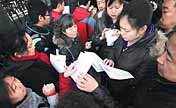
BEIJING, March 11 (Xinhua) -- Worries emerged after China's cash in circulation and deposits hit nearly 100 trillion yuan (16.05 trillion U.S. dollars). However, experts argue that it does not necessarily mean money oversupply.
The broad measure of money supply (M2) rose 15.2 percent year on year to 99.86 trillion yuan by the end of February. Growth was 0.7 percentage points lower month on month but 2.2 percentage points higher than last year, according to the central bank on Sunday.
The ratio of M2 against gross domestic product (GDP) hit about 190 percent, triggering worries of money over-issuance.
If money supply expands along with the real economy simultaneously, M2/GDP ratio should stay at around 150 percent, which means about 75 trillion yuan of M2 will be sufficient for China.
But M2 is currently far more than this, causing inflation and pushing up property prices, according to financial columnist Yu Fenghui in the Bejing News on Monday.
However, Lu Zhengwei, Industrial Bank chief economist, said it is not scientific to judge money over-issuance merely based on M2 and the ratio of it against GDP, though now "most claims are using the two figures."
Lu said, "M2 and the ratio of M2 against GDP have been relatively high in China for a long time, and not a new phenomenon after 2009."
He attributed the situation to China's ongoing monetization reforms, which have put more financial products into market and pushed up demand for money.
Another reason is its social financing structure: most lending is from banks, Lu said.
E Yongjian, a Bank of Communications researcher, agreed that the ratio of indirect lending is relatively low in China's social financing and will result in high M2.
M2/GDP ratio is relatively high in countries where businesses get financing mainly from bank lending and residents' assets are predominantly deposits. M2/GDP ratio is usually low in countries with mature financial markets.
Therefore, it is not meaningful to compare M2 stock and M2/GDP ratio between countries as definitions of money are increasingly blurred with innovative financial tools and M2 calculations being different.

















 Year's first rainfall for Beijing
Year's first rainfall for Beijing


![]()
